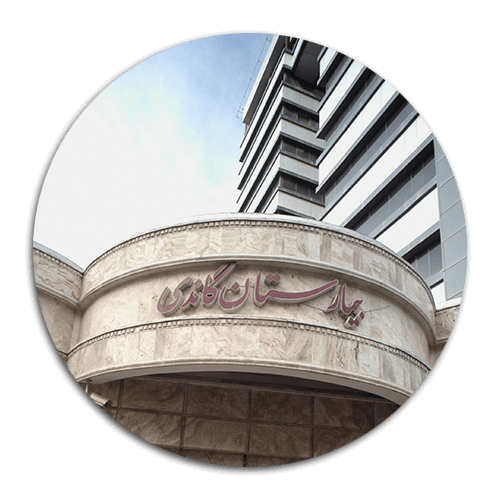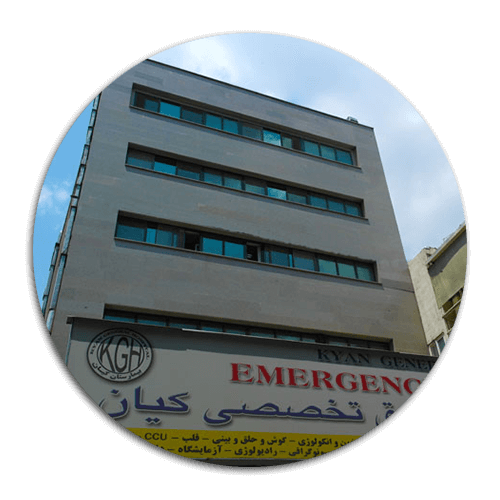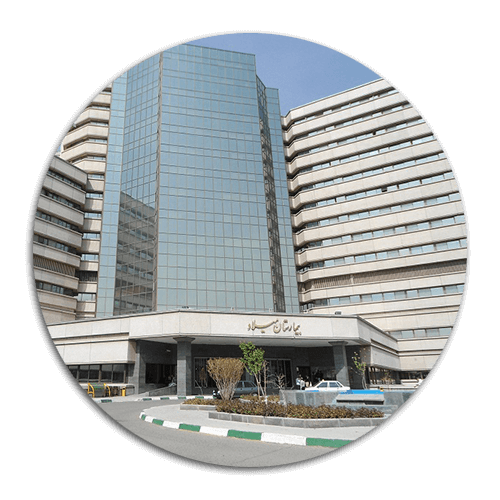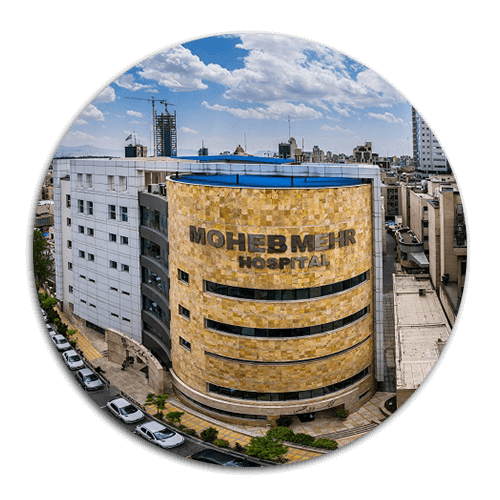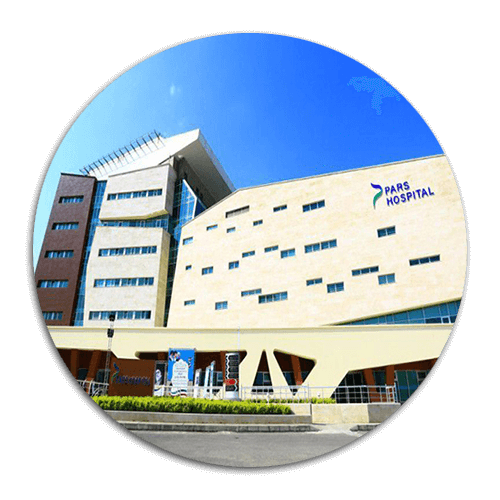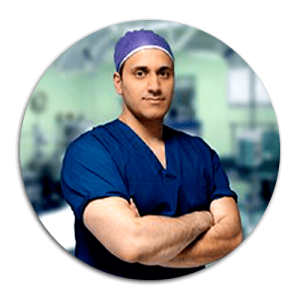All Departments
- Aortic valve stenosis (Aortic stenosis)
- arteriovenous malformations
- Avascular Necrosis
- Best cosmetic dentistry in Iran| Dental Treatment in Iran
- Breast Augmentation in Iran|Breast implant in iran
- Breast Reduction surgery
- Cancer in Iran: oncology in Iran
- Cardiology
- Cataract surgery in Iran
- Cochlear Implant Surgery in Iran
- Cosmetic Laser
- Cosmetic Surgery
- Ear cosmetic surgery
- Eye Care
- Eyelid surgery (Blepharoplasty)
- General Heart Surgery in Iran
- General surgery in Iran
- Glaucoma Treatment In Iran
- Hair Transplant
- Heart valve surgery
- lasik Eye Surgery
- Liposuction
- Non-Surgical Cosmetic procedures in iran
- Organ Transplantation in Iran
- Orthopedic
- Paget disease of bone
- Pediatrics
- Plastic surgery
- Psychiatry
- Radiology
- Rhinoplasty surgery in iran
- Shoulder Replacement Surgery
- SkinCare Treatment
- Spinal cord injury
- urolithiasis procedure in iran
- Urology
- Varicocelectomy
Opening Hours
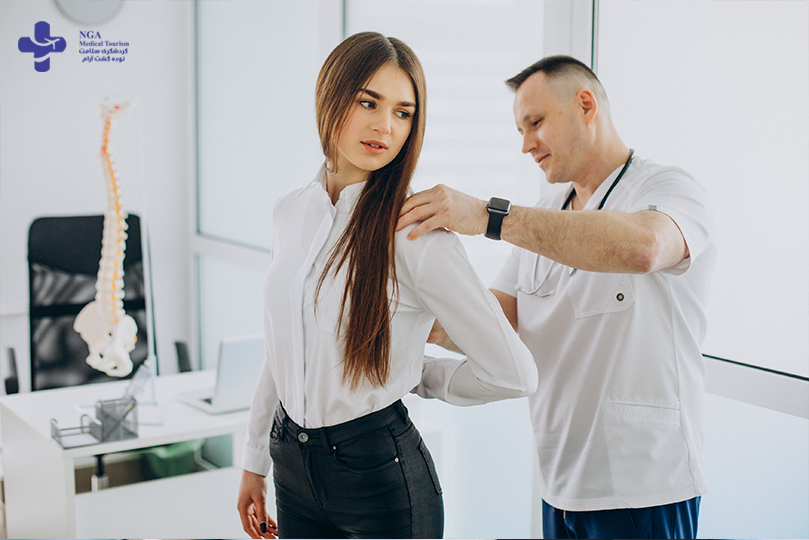
Shoulder Replacement Surgery
COMMON ORTHOPEDIC PROCEDURES
shoulder arthroscopy in iran | shoulder replacement | affordable cost
In recent years, an increasing number of international patients have chosen Iran as their destination for orthopedic treatments, including shoulder replacement surgery. The country offers several advantages, such as competitive pricing, highly skilled orthopedic surgeons, and access to state-of-the-art facilities and equipment. If you’re considering Iran for your shoulder surgery and need more information about the procedure and how to proceed, this article will provide you with the necessary details.
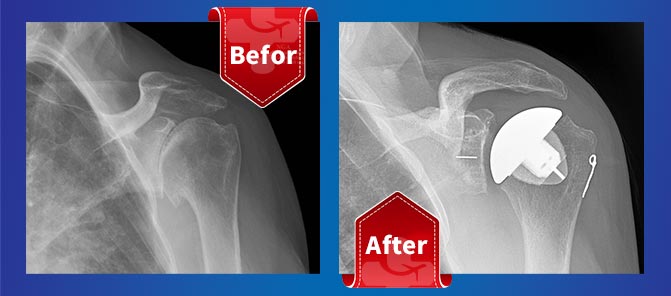
SHOULDER REPLACEMENT IN IRAN: ALL YOU NEED TO KNOW
Total shoulder replacement surgery, also known as shoulder arthroplasty, is a surgical procedure designed to alleviate severe shoulder pain. It is commonly recommended for elderly individuals who have experienced significant wear and tear of the shoulder joint cartilage. During the surgery, the damaged portions of the joint are replaced with artificial components made of metal and plastic.
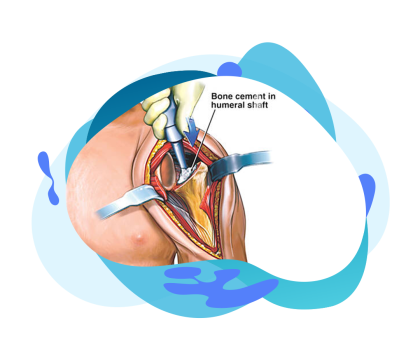
The benefits of total shoulder replacement surgery extend beyond pain relief. After the procedure, patients often regain the ability to engage in various activities, including swimming, individual training, and golf.
If you are considering undergoing total shoulder replacement surgery in Iran, it is important to understand the procedure and what to expect. By choosing Iran as your destination, you can access experienced surgeons and advanced medical facilities. This article will provide you with comprehensive information about total shoulder replacement surgery, as well as insights into the process specific to Iran
What is Shoulder Arthroscopy?
About Shoulder Replacement
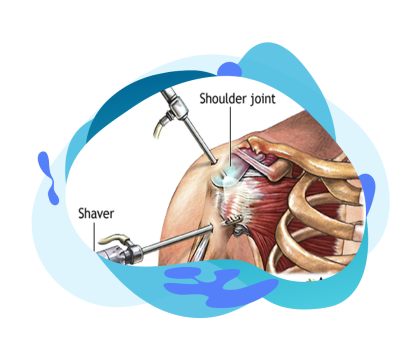
Shoulder arthroscopy is a minimally invasive procedure that effectively treats various shoulder conditions, including damage to the rotator cuff tendons, labrum, articular cartilage, and surrounding soft tissues. This surgical technique serves both diagnostic and therapeutic purposes, offering relief from shoulder pain and addressing a range of shoulder-related issues. Experts highly recommend shoulder arthroscopy as a viable treatment option. Advancements in instruments and techniques continue to enhance the procedure, benefiting both surgeons and patients.
Before undergoing any medical or cosmetic surgery, it is crucial to consult with a knowledgeable surgeon to ensure that you are making the right decision. During the consultation, you should thoroughly discuss your problems and expectations with your doctor so they can recommend the most suitable method based on your needs. Your medical team will guide you through all the stages of the process.
There are several reasons why shoulder arthroscopy is highly sought after in Iran. The foremost reason is the presence of a skilled and certified community of Iranian surgeons who are renowned for their expertise and experience in this field. They have received extensive training and education from reputable Iranian universities and have completed specialized courses and fellowships in well-equipped hospitals. As a result, you can trust them to address your concerns, select the most appropriate method, and help you achieve your goals. They will provide you with detailed information about the entire process, recovery, and healing, along with useful tips to ensure a successful outcome.
Another important factor is the availability of specialized clinics and hospitals across Iran, particularly in major cities such as Tehran, Isfahan, Mashhad, and Shiraz. These facilities offer high-quality services that meet European standards. Furthermore, the cost of shoulder arthroscopy in Iran is significantly lower compared to countries like the US and Turkey, making it a cost-effective option. By choosing to have your surgery in Iran, you can save a considerable amount of money while receiving excellent care.
Lastly, undergoing shoulder arthroscopy in Iran provides an added advantage of exploring the country’s incredible tourist attractions. As a medical tourist, you will have the opportunity to visit some of the most captivating sights and create memorable experiences during your stay.
Considering all these factors, having shoulder arthroscopy in Iran offers a wonderful experience in every aspect, combining exceptional medical care, affordability, and the chance to discover Iran’s cultural and natural treasures.

shoulder workouts
If you have undergone shoulder or knee replacement surgery, it’s important to consult with your doctor or physical therapist before beginning any new exercise routine. They can provide guidance on which exercises are safe and appropriate for your specific condition. Here are some recommended shoulder exercises that may be suitable after shoulder or knee replacement surgery:
- Shoulder External Rotation: This exercise can help improve shoulder mobility and stability. Stand with your elbow bent at a 90-degree angle and your arm against your body. Hold a light weight, such as a dumbbell or resistance band, and slowly rotate your arm outward. Pause, then slowly lower the weight back down. Repeat for several repetitions on each arm.
- Shoulder Abduction: This exercise can help strengthen the muscles around the shoulder joint. Sit or stand with your arms at your sides and hold a light weight in each hand. Slowly raise your arms out to the sides until they are shoulder height, then slowly lower them back down. Repeat for several repetitions.
- Scapular Retraction: This exercise can help strengthen the muscles between your shoulder blades and improve posture. Stand or sit with your arms at your sides and your shoulders relaxed. Squeeze your shoulder blades together, pulling them downward and backward. Hold for a few seconds, then release. Repeat for several repetitions.
- Wall Angels: This exercise can help improve shoulder mobility and flexibility. Stand with your back against a wall and your arms out to the sides at shoulder height. Slowly raise your arms overhead, keeping them in contact with the wall. Pause, then slowly lower them back down. Repeat for several repetitions.
Remember to start with light weights and gradually increase the weight as you get stronger. It’s also important to listen to your body and stop any exercise that causes pain or discomfort.
FIRST OF ALL, HOW DOES YOUR SHOULDER JOINT WORK?
The shoulder joint is a highly intricate structure in the human body, comprising a ball and socket arrangement that connects two bones in the shoulder region. The ball, known as the humeral head or humerus, fits into the socket known as the glenoid. This ball-and-socket configuration allows for the shoulder’s wide range of motion and mobility.
The joint is supported by tendons, bones, and muscles that work together to facilitate proper functioning. Additionally, the ends of the bones in the joint are covered by cartilage, which plays a crucial role in maintaining the shoulder’s flexibility. Cartilage serves as a soft tissue cushion, enabling smooth movement between the bony structures of the shoulder’s ball and socket.
WHY IS A TOTAL SHOULDER REPLACEMENT NEEDED?
There are various reasons why individuals may require a total shoulder joint replacement when other treatment options such as medication or physical therapy have provided limited relief. Some of these reasons include:
- Osteoarthritis: This form of arthritis commonly affects individuals over the age of 50. It leads to the deterioration of cartilage in the shoulder joint, resulting in significant pain.
- Rheumatoid arthritis: In this condition, inflammation of the synovial membrane causes the loss of cartilage in the shoulder joint. The shoulder becomes stiff and painful, limiting joint movement.
- Post-traumatic arthritis: Certain injuries, such as fractures, can cause damage to the cartilage, tendons, and ligaments of the shoulder joint. Immediate attention is required, and a shoulder joint replacement may be necessary.
- Rotator cuff tear arthropathy: The rotator cuff comprises the muscles and tendons surrounding the shoulder joint. When one or more of these structures are injured, a partial or complete tear in the rotator cuff can occur. This leads to changes in the shoulder joint, resulting in arthritis and severe pain. Treatment may involve medication, physiotherapy, or surgery.
- Avascular necrosis (osteonecrosis): When blood supply to the bones is compromised, the shoulder joint can be affected. The lack of blood flow can cause the destruction of bone cells, leading to the need for a shoulder joint replacement.
- Severe fractures: In cases where the upper arm bone’s head is severely fractured, a total shoulder replacement surgery may be required to restore functionality and alleviate pain.
These conditions may necessitate the surgical intervention of a total shoulder joint replacement to improve mobility, relieve pain, and enhance overall shoulder function.
TYPES OF SHOULDER SURGERY
Depending on your specific condition, your doctor may recommend either physiotherapy or surgery as treatment options. In the case of surgery, there are four different types of shoulder arthroplasty procedures:
1- Total shoulder replacement | total shoulder arthroplasty
This procedure involves replacing both the ball (humeral head) and the socket (glenoid) of the shoulder joint with artificial components made of metal and plastic. It is typically recommended for severe arthritis or other conditions causing significant pain and loss of function in the shoulder.
How is a total shoulder replacement performed?
During a total shoulder arthroplasty procedure, the surgery is typically performed under general anesthesia or regional anesthesia. An incision is made in the front of the shoulder, allowing the surgeon access to the affected area. The arthritic surface of the humeral head (ball) is then removed, and a metal prosthesis is inserted in its place.
The orthopedic surgeon may use cement, implants, or grafts to secure the artificial joint components. The socket or glenoid is resurfaced with a smooth plastic component. These components are carefully positioned and secured, ensuring stability and proper alignment.
Once the joint components are in place, the incision is closed using sutures or staples. A bandage is applied to protect the wound and aid in the healing process.
Following the surgery, you will be closely monitored in the hospital for a period of time to ensure proper recovery. Physical therapy and rehabilitation exercises will be prescribed to help regain strength, mobility, and function in the shoulder joint.
It’s important to note that the specific details of the procedure may vary depending on the individual case and the surgeon’s approach.

2- Partial shoulder replacement
Also known as hemiarthroplasty, this procedure involves replacing only the ball of the shoulder joint while keeping the natural socket. It is commonly performed when the humeral head is severely damaged, often due to fractures.
3- Reverse shoulder replacement | shoulder replacement reverse
In this procedure, the positions of the ball and socket components are reversed. The artificial ball is placed on the glenoid, and the artificial socket is attached to the upper end of the humerus. Reverse shoulder replacement is typically recommended for individuals with massive rotator cuff tears or certain complex shoulder conditions.
4- Shoulder resurfacing
This procedure involves replacing the damaged surface of the humeral head with a cap-like implant, preserving the natural socket. It is often performed for younger patients with specific types of shoulder arthritis or osteonecrosis, where the aim is to conserve more bone.
The choice of the appropriate shoulder arthroplasty procedure depends on factors such as the extent of joint damage, the underlying condition, and the individual patient’s specific needs. Your orthopedic surgeon will evaluate your condition and discuss the most suitable treatment approach for you.

what are the limitations after reverse shoulder replacement
After reverse shoulder replacement surgery, there are several limitations and precautions that patients should follow to ensure proper healing and avoid complications. Here are some common limitations and precautions:
Arm immobilization: Patients will typically need to wear a sling or brace for several weeks after surgery to immobilize the arm and allow the joint to heal.
Restrictions on lifting and reaching: Patients should avoid lifting or reaching with the affected arm for several weeks after surgery. Your doctor or physical therapist will provide specific guidelines on when it is safe to resume these activities.
Driving restrictions: Patients should not drive until they have full control and strength in the affected arm and are no longer taking pain medication.
Physical therapy: Physical therapy is typically recommended after reverse shoulder replacement surgery to help restore range of motion, strength, and flexibility to the shoulder. Patients should follow the recommended exercises and precautions provided by their physical therapist.
Avoiding high-impact activities: Patients should avoid high-impact activities, such as running or jumping, that could put stress on the shoulder joint.
Follow-up appointments: Patients should attend all follow-up appointments with their doctor to monitor the healing process and ensure that the shoulder is functioning properly.
Why should you travel to Iran for a shoulder replacement?
Many patients choose to undergo shoulder replacement surgery in Iran due to several reasons. One of the main factors is the high success rates of Iranian specialists and surgeons in performing this procedure.
In addition, the cost of shoulder replacement in Iran is relatively low compared to other countries, making it an affordable option for patients seeking this treatment. The cost of accommodation in Iran is also affordable, contributing to the overall cost-effectiveness of the procedure.
Iran boasts a large number of well-experienced doctors specializing in shoulder replacement, ensuring that patients receive expert care and treatment. Furthermore, shoulder replacement centers in Iran adhere to European standards, providing the highest quality operations and ensuring patient satisfaction.
Considering these factors, it is not surprising that many patients choose to undergo shoulder replacement surgery in Iran, benefiting from the expertise of skilled surgeons, cost-effectiveness, and high-quality healthcare services.
SHOULDER REPLACEMENT SURGERY COST IN IRAN
The average cost of shoulder arthroscopy in Iran ranges from $1,900 to $3,500, which typically includes the doctor’s visit, hospital charges, anesthesia, post-operative recovery, and follow-up care. The actual price may vary based on factors such as the reputation and expertise of the surgeon, the complexity of the procedure, and the severity of the condition. Opting for a less experienced surgeon may lower the cost, but it is important to carefully consider the surgeon’s qualifications.
While the cost of shoulder arthroscopy in Iran is significantly more affordable compared to other renowned countries in this field, it is important to note that affordability does not compromise the safety or quality of the procedure. In fact, many patients choose Iran for medical or cosmetic surgeries based on factors beyond cost. The country offers a high standard of safety and quality, as reported by patients who have undergone treatments there.
In addition to the reasonable treatment costs, Iran’s low accommodation expenses and the presence of numerous specialized clinics attract candidates from around the world. Traveling to Iran for shoulder arthroscopy allows patients to access top-notch medical care while enjoying the benefits of affordable accommodation.
If you are considering traveling to Iran for shoulder arthroscopy surgery, it is highly recommended to consult with a medical tourism company such as IPD Tourism. These companies can assist you in exploring available options, finding experienced and knowledgeable specialists based on your specific goals, and facilitating the visa application process. Their expertise can simplify the entire process and ensure a smooth medical journey for you.
anterior dislocation of shoulder
Anterior dislocation of the shoulder is a common type of shoulder injury that occurs when the upper arm bone (humerus) comes out of the shoulder socket (glenoid). This type of dislocation accounts for about 95% of all shoulder dislocations.
Anterior shoulder dislocation can occur due to a variety of reasons, including trauma, sports injuries, or repetitive strain. It can cause pain, swelling, and limited range of motion in the affected shoulder. Other symptoms may include numbness, tingling, or weakness in the arm or hand.
Treatment for anterior shoulder dislocation typically involves reducing the dislocation, or putting the humerus back into the glenoid socket. This can be done through closed reduction, which involves manipulating the arm to guide the humerus back into place. In some cases, surgery may be necessary to repair any damage to the shoulder joint or surrounding tissues.
After the dislocation has been reduced, the shoulder may be immobilized in a sling or brace for several weeks to allow the joint to heal. Physical therapy may also be recommended to help restore range of motion, strength, and flexibility to the shoulder.
reverse total shoulder replacement:
Reverse total shoulder replacement is a surgical procedure used to treat severe shoulder arthritis or rotator cuff tears that cannot be repaired with traditional surgery. This procedure is called a “reverse” shoulder replacement because it reverses the anatomy of the shoulder joint, placing the ball component on the shoulder blade and the socket component on the upper arm bone.
During the surgery, the damaged bone and cartilage are removed from the shoulder joint, and the surgeon replaces the joint with a metal and plastic prosthesis. The reverse design of the prosthesis allows the deltoid muscle, which is the main muscle responsible for lifting the arm, to compensate for the loss of function of the rotator cuff muscles.
Who Can Benefit from Shoulder Arthroscopy?
Shoulder arthroscopy is recommended when non-surgical treatments have failed to alleviate pain in the shoulder. It is particularly effective for conditions such as shoulder instability, torn or damaged cartilage (labrum) or ligaments, rotator cuff tears, biceps tendon tears or damage, inflammation or damage to the joint lining, bone spurs or inflammation around the rotator cuff, arthritis of the collarbone, and the removal of loose tissue. This minimally invasive procedure can reduce inflammation, promote healing, and address various shoulder-related issues.
is shoulder replacement surgery worth it?
shoulder replacement surgery is a major procedure that carries risks, such as infection, bleeding, nerve damage, or implant failure. Recovery can also be a long process, requiring several weeks or months of rehabilitation and physical therapy to regain strength and mobility in the shoulder.
Whether shoulder replacement surgery is worth it depends on the individual’s specific condition and goals. For some patients, the pain and disability caused by shoulder arthritis or other conditions may severely limit their ability to perform daily activities, work, or enjoy hobbies. In these cases, shoulder replacement surgery may be a viable option to improve their quality of life.
Our Services
Your message will be reviewed by our doctors and specialist . We will get back to you within 24 Hours.
Nodeh Gasht Aram experts will answer your questions 24/7 , through online chat or by phone.
You get medical opinion and cost estimate
Nodeh Gasht Aram plan your trip.
We arrange your medical visa , flight, ticket, appointments, accommodation etc.
Booking various types of accommodation
interpreter
insurance
SIM & Internet
City Tour
Collaboration with different medical centers to get the best diagnosis and treatment by talent doctors and surgeons...
Post-treatment recuperation and check up .
After the completion of treatment and you return to your country, we will follow you around the clock.
Why Nodeh Gasht Aram?
- Contact Us Via Whatsapp: Your message will be reviewed by our doctors and specialist . We will get back to you within 24 Hours.
- Free Consultation: Nodeh Gasht Aram experts will answer your questions 24/7, through online chat or by phone.
- Qoutation: You get medical opinion and cost estimate
- Ticketing & Visa Support: Nodeh Gasht Aram plan your trip We arrange your medical visa , flight, ticket, appointments, accommodation etc.
- Hotel Booking,Travel Insurance,Interpreter: Booking various types of accommodation, interpreter, insurance, SIM & Internet, City Tour
- Hospitality & Diagnosis & Treatment: Collaboration with different medical centers to get the best diagnosis and treatment by talent doctors and surgeons.
- Recovery: Post-treatment recuperation and check up .
- Follow-up: After the completion of treatment and you return to your country, we will follow you around the clock.
The most common arthroscopic procedures are:
Shoulder arthroscopy is commonly performed for a range of procedures, including:
otator cuff repair:
Surgical repair of a torn rotator cuff tendon to restore proper function and alleviate pain.
Labrum removal or repair:
The labrum, a cartilage ring that surrounds the shoulder socket, may need to be removed or repaired if damaged.
Ligament repair:
Surgical repair of damaged ligaments in the shoulder joint to restore stability and function.
Removal of inflamed tissue or loose cartilage:
Inflamed tissue or loose cartilage within the shoulder joint can be removed to relieve pain and improve joint movement.
Repair for recurrent shoulder dislocation:
Surgical intervention to address recurring shoulder dislocations and stabilize the joint.
These procedures are typically performed using arthroscopic techniques, which involve making small incisions and using a specialized camera and surgical instruments to visualize and treat the shoulder joint. Arthroscopy offers several benefits, including smaller incisions, reduced scarring, faster recovery, and less post-operative pain compared to traditional open surgery.
The most common arthroscopic procedures are:
Shoulder arthroscopy is commonly performed for a range of procedures, including:
otator cuff repair:
Surgical repair of a torn rotator cuff tendon to restore proper function and alleviate pain.
Labrum removal or repair:
The labrum, a cartilage ring that surrounds the shoulder socket, may need to be removed or repaired if damaged.
Ligament repair:
Surgical repair of damaged ligaments in the shoulder joint to restore stability and function.
Removal of inflamed tissue or loose cartilage:
Inflamed tissue or loose cartilage within the shoulder joint can be removed to relieve pain and improve joint movement.
Repair for recurrent shoulder dislocation:
Surgical intervention to address recurring shoulder dislocations and stabilize the joint.
These procedures are typically performed using arthroscopic techniques, which involve making small incisions and using a specialized camera and surgical instruments to visualize and treat the shoulder joint. Arthroscopy offers several benefits, including smaller incisions, reduced scarring, faster recovery, and less post-operative pain compared to traditional open surgery.
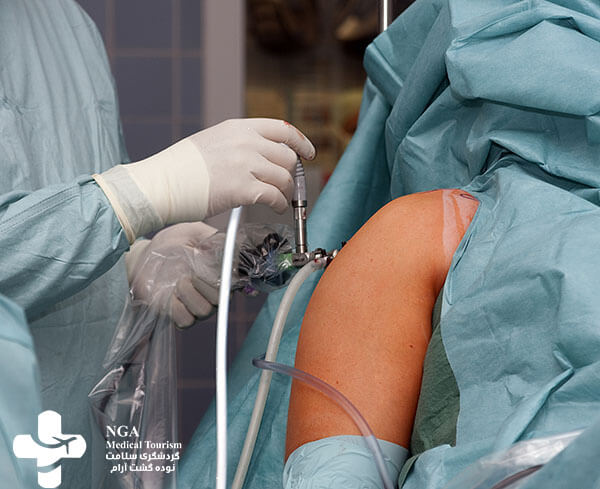
Things to know about Shoulder Arthroscopy in Iran
What to do before a total shoulder arthroplasty?
Before your surgery, it is important to follow these guidelines:
- Consult with your family physician for a comprehensive physical examination.
- Two weeks prior to the surgery, discontinue the use of medications such as blood thinners, non-steroidal anti-inflammatory drugs, and arthritis medications if instructed by your surgeon.
- Arrange your home in a way that essential items are easily accessible during your recovery. Consider placing them in lower cupboards for convenience.
- Additional tests such as blood tests, MRI, and bone scans may be required as part of your pre-surgery preparation.
- Provide your complete medical history to your healthcare provider.
- Ensure that you have someone available to assist and support you with daily activities such as bathing, dressing, and cooking. If not, consider a rehabilitation facility as a viable option.
- Refrain from eating and drinking 12 hours prior to the scheduled surgery.
- It is advisable to abstain from alcohol for at least one month before the surgery.
- Quit smoking as it can have detrimental effects on the healing process.
Following these guidelines will help ensure a smooth and successful surgical experience.
Shoulder Arthroscopy Procedure
During arthroscopic shoulder surgery, there are two common positions in which you may be placed:
Beach chair position: You will be in a semi-seated position similar to sitting in a reclining chair. This allows for easy access and visibility of the shoulder joint.
Lateral decubitus position: You will lie on your side on an operating table. This position provides a different angle for the surgeon to access and operate on the shoulder.
Before Shoulder Replacement
Before the procedure begins, your surgical team will clean the skin with an antiseptic solution and drape your shoulder and arm with sterile covers. Your forearm will be secured in a holding device to prevent movement.
To enhance visibility, fluid may be injected into your shoulder joint, which helps inflate it. A small puncture (about the size of a buttonhole) is made for the arthroscope, a small camera, to be inserted. Fluid continuously flows through the arthroscope to maintain a clear view and control any bleeding. The arthroscope transmits images to a video screen, allowing the surgeon to see inside your shoulder.
During Shoulder Replacement
Once the problem is identified, your surgeon will use tiny instruments inserted through separate incisions to perform the necessary treatment. These instruments can be used for tasks such as shaving, cutting, grasping, passing sutures, and tying knots.
After the procedure, your incisions will be closed with stitches or covered with small Band-Aids. A large, soft bandage will be applied to protect the area. Due to the minimally invasive nature of arthroscopy, patients generally experience less pain and have a shorter recovery period compared to open surgery.
Shoulder Arthroscopy Recovery Time | shoulder replacement surgery recovery time
SHOULDER REPLACEMENT RECOVERY: WHAT TO EXPECT?
The recovery period after shoulder arthroscopy can vary depending on the complexity of the procedure, ranging from one to six months. After the surgery, you will spend about 1 to 2 hours in the recovery room before being discharged home. During this time, your medical team will monitor your responsiveness and provide pain medication if needed. It is advisable to have someone assist you during the first few days after the surgery to ensure proper rest, as rest is essential for a better recovery.
You will need to wear a sling for several weeks following the surgery and may experience some pain or discomfort. These complications are normal and tend to resolve over time. Your surgeon will provide you with helpful tips to manage pain, such as using ice to alleviate pain and reduce swelling. Applying ice for 20-30 minutes at a time, every hour or two, can be beneficial. Pain medication may also be prescribed, including opioids, nonsteroidal anti-inflammatory drugs (NSAIDs), and local anesthetics. It is important to use opioids only as prescribed by your doctor and to stop taking them once the pain subsides, as they can be addictive.
Finding a comfortable sleeping position, such as lying flat or using a reclining chair, can help reduce pain during the initial days after the surgery. As time progresses, you can replace the large bandage with simple Band-Aids and shower once the wounds are no longer draining, avoiding soaking or scrubbing the stitches.
Following this initial stage, you will need to follow an exercise program to regain shoulder strength and motion. Your doctor will design a rehabilitation plan based on the specific surgical procedures performed and the severity of your condition. In some cases, a physical therapist may be recommended to supervise the exercise program.
Regular follow-up appointments with your surgeon will be necessary to inspect the incisions, remove sutures, and address any questions or concerns you may have.
Most patients can return to work, school, or daily activities within a few weeks if they are in good overall physical health. However, the recovery period can vary for each individual, and it is important to listen to your body and take the necessary time off work or activities until the pain subsides and you feel comfortable. The length of the recovery period cannot be predicted in advance and may differ for each person.
deltoid muscle pain after reverse shoulder replacement
Deltoid muscle pain is a common symptom following reverse shoulder replacement surgery. This is because the deltoid muscle, which is the main muscle responsible for lifting the arm, can become inflamed and sore due to the surgery and the changes in the shoulder joint.
To manage deltoid muscle pain after reverse shoulder replacement surgery, the following steps may be helpful:
- Pain management: Your doctor may prescribe pain medication or recommend over-the-counter pain relief medications to help manage the pain. It’s important to follow your doctor’s instructions and not exceed the recommended dosage.
- Physical therapy: Your doctor or physical therapist may recommend specific exercises to help stretch and strengthen the deltoid muscle and improve the range of motion in the shoulder joint.
- Ice and heat therapy: Applying ice or heat to the affected area can help reduce inflammation and alleviate pain. Your doctor or physical therapist can provide guidance on when and how to apply ice or heat therapy.
- Rest and relaxation: It’s important to give your body time to rest and heal after surgery. Avoid overusing or straining the affected arm, and try to get plenty of rest and relaxation.
- Follow-up appointments: Attend all follow-up appointments with your doctor to monitor the healing process and ensure that the shoulder is functioning properly. Be sure to report any persistent or worsening pain or other symptoms to your doctor.
Shoulder Arthroscopy Results
After undergoing shoulder arthroscopy, many patients experience significant relief from their shoulder-related problems and are able to move their shoulders without pain. Following your surgeon’s guidelines and adhering to the rehabilitation plan are crucial for achieving a successful outcome. By actively participating in the prescribed exercises and taking care of your shoulder during the recovery period, you can enhance the healing process and improve your shoulder function. It is important to communicate any concerns or difficulties to your medical team to ensure proper support and guidance throughout your recovery journey. With dedication and patience, you can expect positive results and a resolution to your shoulder issues.
Shoulder Arthroscopy Pre-Operative Considerations
Before shoulder arthroscopy, consult a certified surgeon and discuss your goals, medical conditions, and current medications. Inquire about medication usage on the day of surgery. Address any underlying health issues beforehand. Inform your healthcare provider about excessive alcohol consumption.
Then, your surgeon will:
- Review medical history and previous surgeries
- Assess overall health and examine shoulders
- Take photos for medical records
- Advise on smoking cessation for improved recovery and healing
- Instruct to avoid certain medications and supplements that may increase bleeding and bruising
- Inquire about any illnesses or symptoms before surgery
- Discuss treatment options and recommend a course of action
- Provide instructions for pre-operative preparation
- Explain potential outcomes and possible complications.
Best shoulder replacement hospital in Iran
A large number of Iranian and foreign patients are going under shoulder replacement in Iran each month. shoulder replacement in Iran is on top of the middle-east regarding its skilled specialists and surgeons. Here are the best hospitals for shoulder replacement in Iran:
Shoulder Replacement in Iran | Best Doctors & Orthopedists
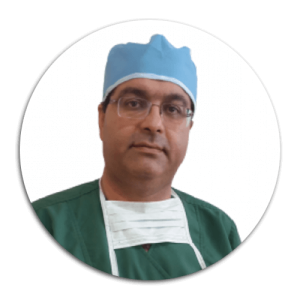
Dr Morteza Nakhaei
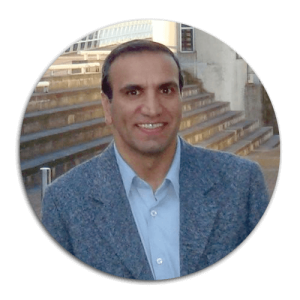
Dr. mohammad nasir naderi

Dr Hasan Ghandehari
cost of orthopedic surgery | cost of shoulder replacement
Department of Orthopedics | Orthopedic surgery cost ($ US) |
|---|---|
Shoulder Replacement | 3500 $ |
Bunion surgery | 2000 $ |
Spinal surgery | 3000 $ |
ACL surgery | 1700 $ |
Hip replacement | 3500 $ |
Knee replacement | 4000 $ |
Knee arthroscopy | 1200 $ |
Carpal tunnel surgery | 400 $ |
Achilles tendon repair surgery | 2400 $ |
Elbow replacement | 2600 $ |
Hand and wrist surgery | 1700 $ |
Ankle replacement | 3200 $ |
Conclusion:
Shoulder replacement surgery can be a highly effective treatment option for individuals with severe shoulder pain or disability due to conditions such as arthritis, rotator cuff tears, or fractures. While the procedure carries risks, advances in surgical techniques and materials have significantly improved the safety and success of the surgery. Recovery can be a long process, but with proper care and rehabilitation, many patients are able to regain full function in their shoulder after the surgery.
FREQUENTLY ASKED QUESTIONS ABOUT SHOULDER REPLACEMENT IN IRAN
If you have tried medication and physiotherapy without success, suffer from severe arthritis, seek a fast recovery, have intact rotator cuff tendons, struggle with pain that hinders daily activities, experience weakness and limited range of motion in the shoulder, and have difficulty sleeping due to pain at night, then you are an ideal candidate for total shoulder arthroplasty.
Shoulder replacement surgery carries rare risks and complications, including infection, blood clots, swelling, joint stiffness, nerve or vessel damage, and instrument breakage. Surgeons take precautions to minimize these risks.
Shoulder arthroscopy is a popular choice for diagnosing and treating shoulder issues, particularly for those with persistent pain. It offers advantages over open surgery, being less invasive and more patient-friendly. Many patients can go home shortly after the outpatient procedure, experiencing less post-operative pain and enjoying a quicker recovery compared to open surgery. These factors make shoulder arthroscopy an appealing option for individuals seeking effective treatment for shoulder conditions.
Arthroscopic debridement is a minimally-invasive procedure for treating shoulder joint damage caused by conditions like arthritis or overuse. It involves using small surgical instruments to remove damaged cartilage or bone fragments. A tiny camera called an arthroscope is inserted to provide a clear view of the shoulder joint. A joint washout, or lavage, may also be performed to clean the area. Any remaining loose bodies or fragments are carefully extracted. Arthroscopic debridement aims to enhance shoulder function and reduce pain by addressing the underlying sources of damage or irritation within the joint.
The duration of recovery after arthroscopic debridement can vary depending on factors such as the severity of the condition and the individual’s overall health. The expected pain following the procedure typically subsides within 12 to 24 hours. Once you feel comfortable, you can gradually resume your work and daily activities. While many patients experience significant improvement within a month, others may require a recovery period of 6 weeks or longer. It is important to follow your surgeon’s post-operative instructions and engage in any prescribed rehabilitation or physical therapy to optimize your recovery and regain full shoulder function.
While shoulder arthroscopy is generally considered a safe surgical procedure, it is important to be aware of potential complications and risks associated with the surgery. Your doctor will discuss these with you in detail to ensure you have a comprehensive understanding and can make an informed decision. Some possible complications include infection, bleeding, damage to surrounding structures, nerve or blood vessel injury, blood clots, stiffness, and adverse reactions to anesthesia. By discussing these risks with your doctor and following their guidance, you can mitigate potential complications and increase the likelihood of a successful outcome.
The length of time off work after shoulder arthroscopy varies based on individual factors. Generally, patients can expect to take 1-2 weeks off, but it may extend to 4-6 months for complex cases or physically demanding jobs. Desk job workers may return sooner, while those with physically demanding roles may need more time to recover. Following your doctor’s advice is crucial for a successful recovery and to prevent complications.
Deep infections after shoulder arthroscopy are uncommon but require prompt treatment. Early detection is vital, and surgical intervention may be necessary. Debridement, a procedure that involves removing contaminated tissues through joint washout, is performed to control the infection and promote healing. Timely management is crucial to prevent complications and support patient recovery.
Postoperative pain after shoulder arthroscopy gradually improves over time, typically within the first month.
Complications of total shoulder arthroplasty include nerve damage, infection, shoulder stiffness, blood vessel injury, fracture, anesthetic complications, bleeding, blood clots, tendon and muscle failure, blood pressure issues, and breathing problems. Adhering to pre-operative and post-operative instructions can help minimize these risks.
Shoulder replacement surgery is safe and effective, with shorter recovery times compared to hip and knee surgeries, according to Johns Hopkins research. Consult with your doctor to determine if it’s the right option for you.
Shoulder replacement surgery is safe and effective, with shorter recovery times compared to hip and knee surgeries, according to Johns Hopkins research. Consult with your doctor to determine if it’s the right option for you.
For shoulder replacement surgery, the typical stay in the country is 1 to 3 weeks before you can safely return home by air.
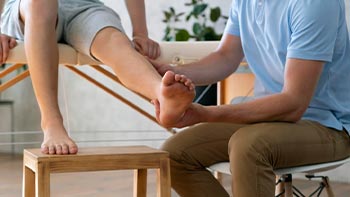
Achilles tendon repair is a surgical procedure to treat a ruptured or torn Achilles tendon, which is the largest tendon in the body that connects the calf muscle to the heel bone. This injury is typically caused by sudden, forceful movements or overuse. During …

Bunion surgery is a procedure to correct a bunion, which is a bony bump that forms on the joint at the base of the big toe. This bump can cause pain and discomfort, and make …
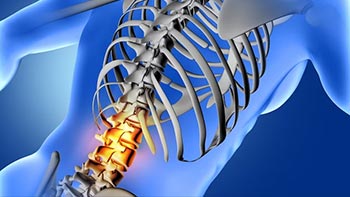
Disc hernia surgery is a procedure to treat a herniated disc, which occurs when the soft tissue inside the spinal disc pushes through a crack in the outer layer of the disc. This can …
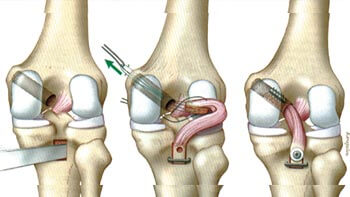
ACL and PCL reconstruction surgery is a procedure to repair a torn anterior cruciate ligament (ACL) or posterior cruciate ligament (PCL) in the knee. These ligaments help keep …

Knee osteotomy is a surgical procedure to treat knee arthritis by reshaping the bones in the knee joint. This procedure is typically recommended for individuals with early-stage arthritis who have …

Arthroscopic knee debridement is a minimally invasive surgical procedure that involves removing damaged tissue from the knee joint. This procedure is typically recommended for …
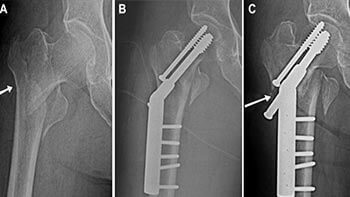
Hip nailing is a surgical procedure to treat a fractured hip by inserting a nail or rod into the femur bone to stabilize and support the hip joint. This procedure is typically recommended for …
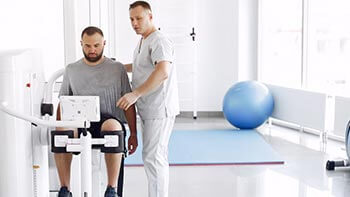
Rehabilitation is a process of restoring physical, mental, and emotional health and function after an illness, injury, or surgery. The goal of rehabilitation is to help individuals regain independence, improve …
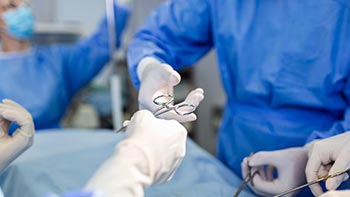
Laminectomy is a surgical procedure to relieve pressure on the spinal cord or nerves by removing part of the lamina, which is the bony covering of the spinal canal. This procedure is typically recommended for individuals with conditions such as spinal stenosis …
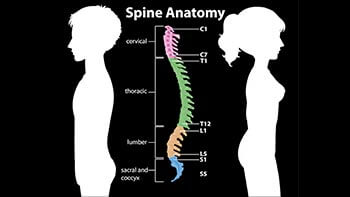
Spinal fusion is a surgical procedure to join two or more vertebrae together in the spine to stabilize the spine and reduce pain caused by conditions such as herniated discs, spinal stenosis, or scoliosis. During spinal fusion, the surgeon will use bone grafts, metal …
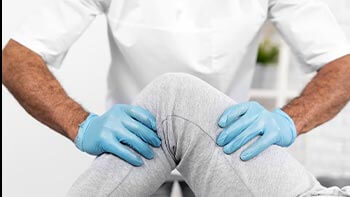
Meniscus repair is a surgical procedure to treat a torn meniscus, which is a piece of cartilage in the knee joint that acts as a shock absorber. This procedure is typically recommended for individuals with a meniscus tear caused by injury or degeneration. During …



